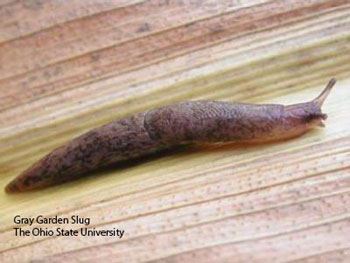Preventing Slug Damage In Corn And Soybean
PRINCETON, KY.
Is there something predictive about writing an article on slugs
(Figure 1) while it is cold, rainy, and the ground is soggy? Let’s hope
not. At any rate, I have received several questions mainly concerning
whether or not this past difficult winter will reduce slug problems.
Though I am no expert on slugs, I do know people that are! Their answer
to this question is generally a slightly hedged “no.”

Figure 1. Grey garden slug
Apparently slugs are very good at overwintering. They have the
ability to move very deep in the soil and, thus, to avoid the extremes
in temperature that we have seen. In addition, during some of our very
cold periods, we had significant snow coverage on the ground. Snow acts
as an insulator and though the ground may (probably will) freeze, soil
temperatures may not reach the very low levels that air temperatures
reach.
While most people with experience in slug biology will agree that
there will probably be a greater level of over wintering mortality this
year, that increase in mortality may not have a direct effect on the
slug damage you may see in the field. Here is an example why.
Note: The following numbers are made up for illustration and don’t bear any resemblance to the real levels.
Just suppose it requires 10 slugs per square foot to cause economic
damage. Also, that in most years 100 slugs per square foot go into
winter and 20 percent of them survive the winter. That still leaves 20
slugs per square foot to cause damage the following spring. So, if in
this past winter, the mortality of overwintering slugs goes up from 80
percent mortality to 90 percent mortality this still leaves 10 slugs per
square foot to cause economic damage. Yes, winter has resulted in fewer
slugs to damage the crop, but not enough fewer to prevent problems.
In addition, winter weather, though important, is probably not as
important as the weather that occurs when slugs are infesting your
crops. Crops that are planted in cold, wet ground struggle to germinate
and grow. So, if you will, the plants are less vigorous. However, slugs,
if not enjoying cold, wet, overcast days, are at least better adapted
to that weather than are our crop plants. So in these cases the same
number of slugs per plant unit will cause more damage during cold, wet,
overcast weather than they will during warm, sunny days, which favor the
crop plants.
I know of no pesticide control that is really useful in controlling
slugs in corn and soybean. Yes, there are some available, but the chance
of obtaining an economically positive response with them is
diminishingly small. Your best bet is to plant into moist but well
drained soil when the weather is suited for a quick emergence and
sustained growth of the plants. This is especially true if you are
planting into an area with a history of slug problems. Not easy to time I
know, but that is about the best strategy to avoid slug damage.∆
DR. DOUG JOHNSON: Extension Professor of Entomology and IPM Coordinator, University of Kentucky